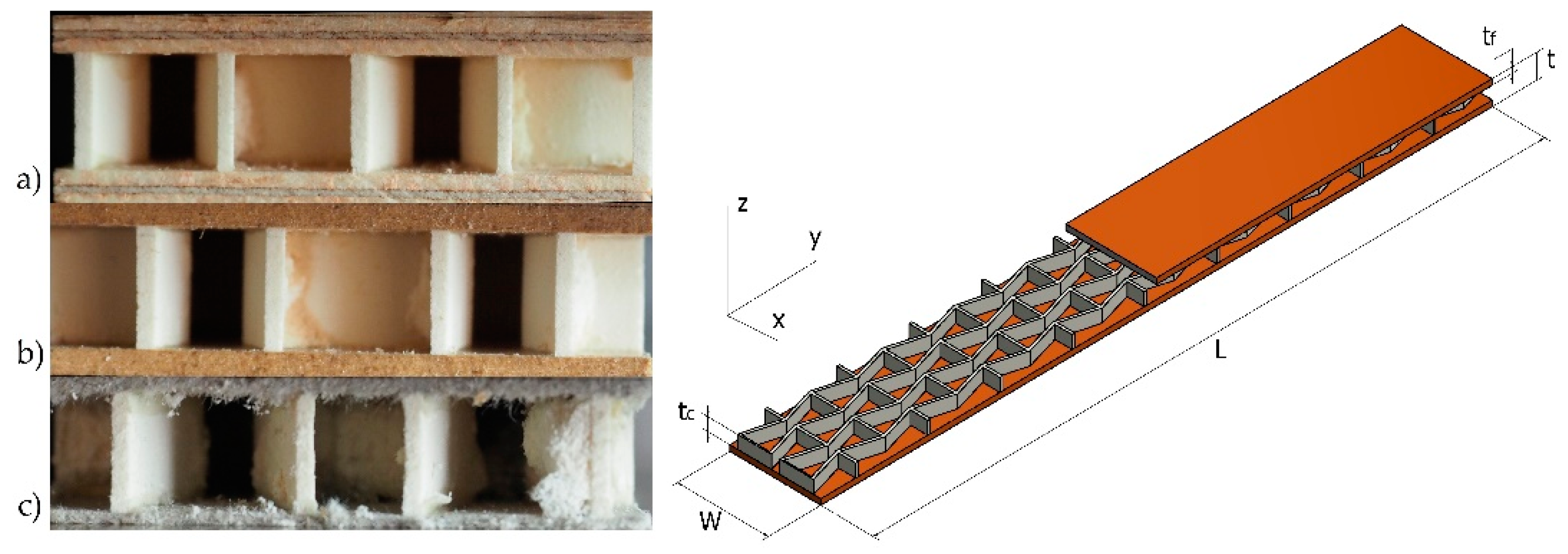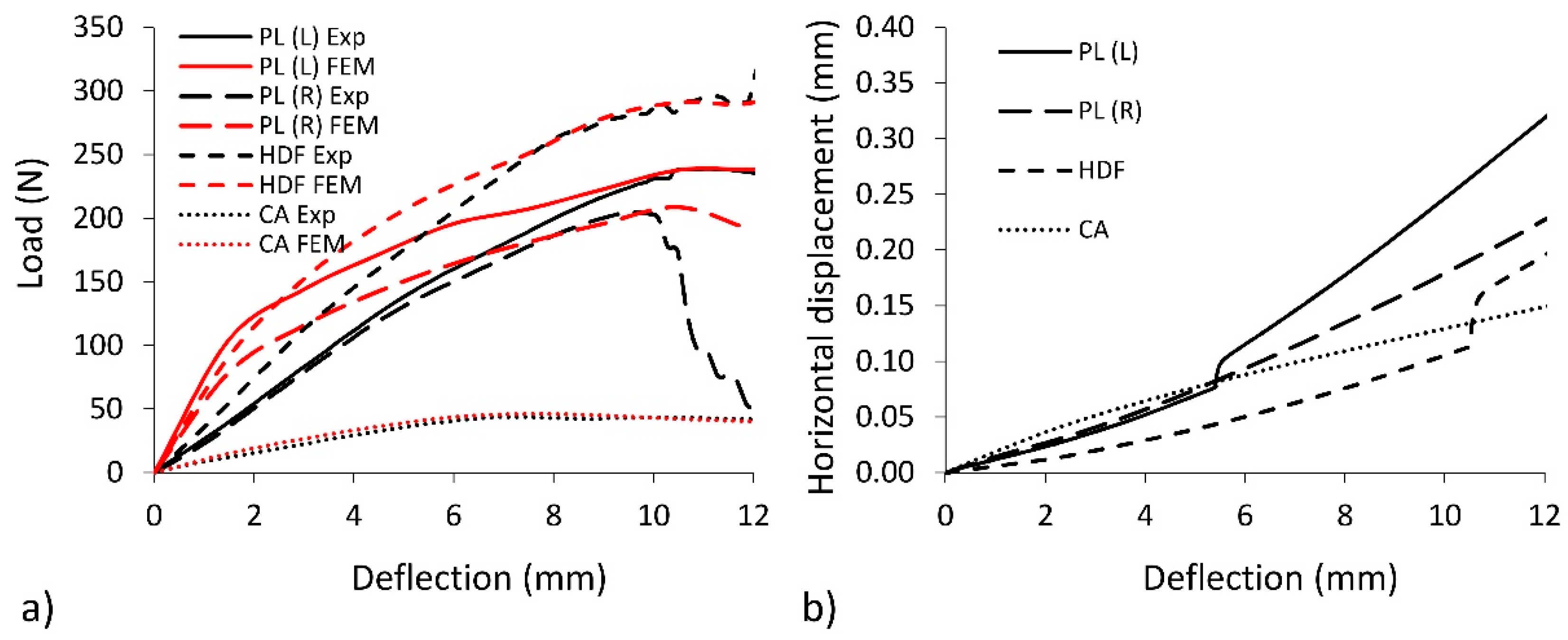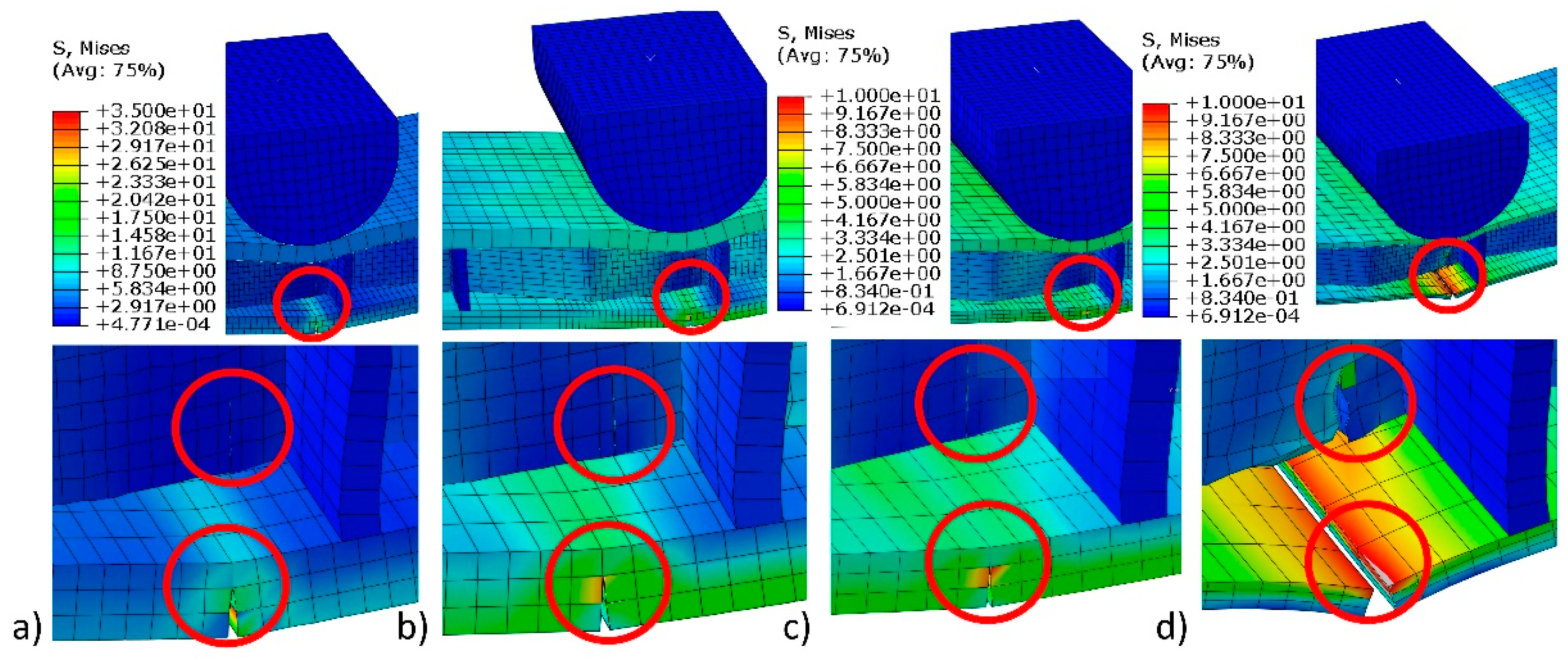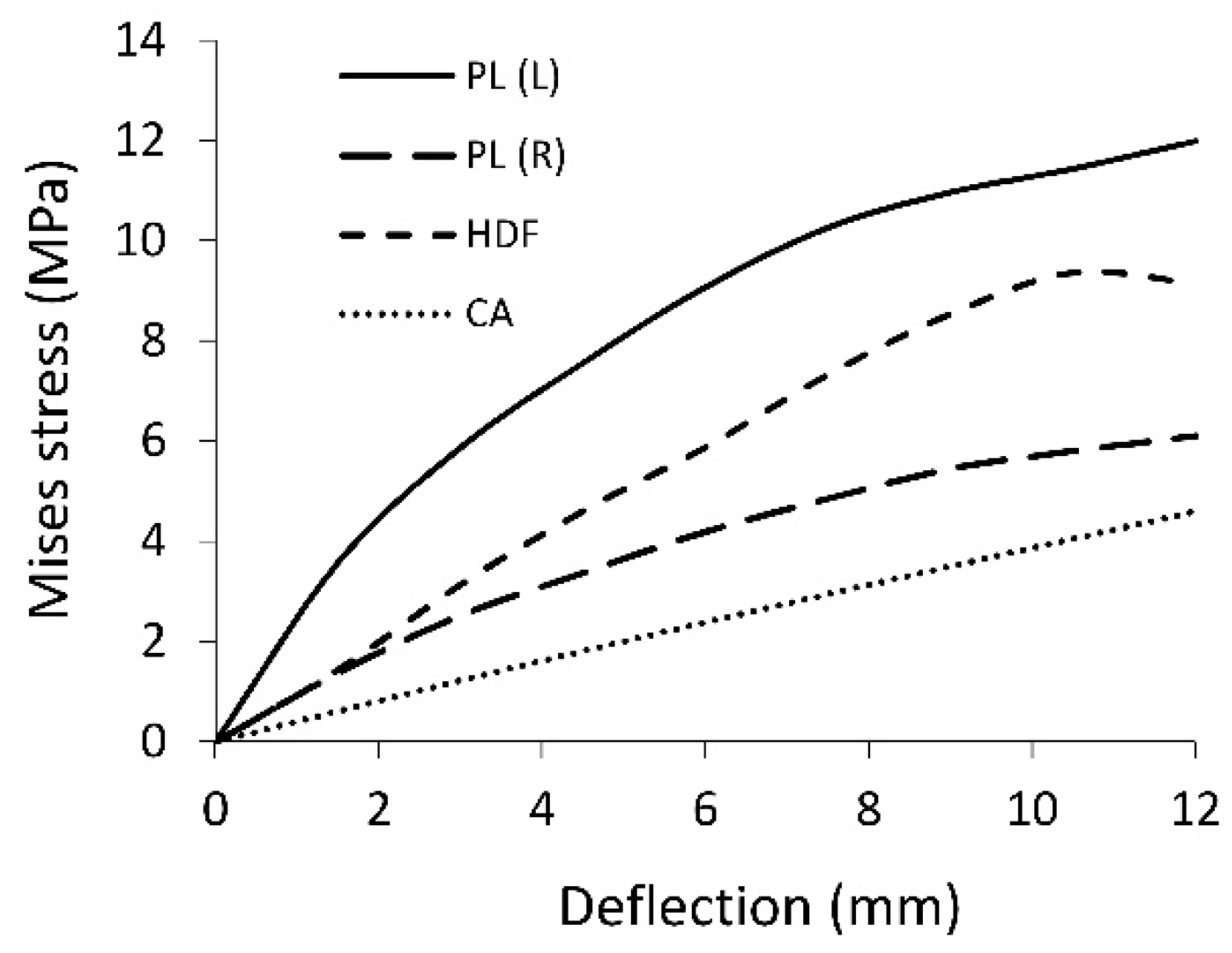Bending Behavior of Lightweight Wood-Based Sandwich Beams with Auxetic Cellular Core
Abstract
1. Introduction
2. Materials and Methods
2.1. Tests of Materials
2.2. Manufacturing of Auxetic Wood-Based Sandwich Panels
2.3. Bending Tests
2.4. Numerical Model
3. Results and Discussion
3.1. Mechanical Properties of Multilayered Beams
3.2. Damage and Energy Absorption by the Sandwich Beams
4. Conclusions
Author Contributions
Funding
Acknowledgments
Conflicts of Interest
References
- Rupani, S.V.; Jani, S.S.; Acharya, G.D. Design, Modelling and Manufacturing aspects of Honeycomb Sandwich Structures: A Review. Int. J. Sci. Dev. Res. 2017, 2, 526–532. [Google Scholar]
- Marsh, G.; Jacob, A. Trends in marine composites. Reinf. Plast. 2007, 51, 22–27. [Google Scholar] [CrossRef]
- Cunningham, P.R.; White, R.G. Free vibration of doubly curved composite honeycomb rectangular sandwich panels. In Proceedings of the IMACXVII: 17th International Modal Analysis Conference, Bellingham, WA, USA, 8–11 February 1999; pp. 65–71. [Google Scholar]
- Negro, F.; Cremonini, C.; Zanuttini, R.; Properzi, M. A new wood-based lightweight composite for boatbuilding. Wood Res. 2011, 56, 257–266. [Google Scholar]
- Prucz, J.C.; Shoukry, S.N.; William, G.W.; Shoukry, M.S. Lightweight Composite Materials for Heavy Duty Vehicles; West Virginia University: Morgantown, WV, USA, 2013. [Google Scholar] [CrossRef]
- Jen, Y.; Chang, L. Evaluating bending fatigue strength of aluminum honeycomb sandwich beams using local parameters. Int. J. Fatigue 2008, 30, 1103–1114. [Google Scholar] [CrossRef]
- Chang, C.C.; Ebcioglu, I.K. Efect of cell geometry on the shear modulus and on density of sandwich panel cores. J. Basic Eng. 1961, 83, 513–517. [Google Scholar] [CrossRef]
- Smardzewski, J. Elastic properties of cellular wood panels with hexagonal and auxetic cores. Holzforschung 2013, 67, 87–92. [Google Scholar] [CrossRef]
- Smardzewski, J. Mechanical properties of wood-based sandwich panels with a wavy core. In Proceedings of the XXVII International Conference Research for Furniture Industry, Ankara, Turkey, 17–18 September 2015; pp. 242–255. [Google Scholar]
- Bitzer, T.N. Honeycomb Technology: Materials, Design, Manufacturing, Applications and Testing; Springer Science & Business Media: London, UK, 1997. [Google Scholar]
- Pour, N.; Itzhaki, L.; Hoz, B.; Altus, E.; Basch, H.; Hoz, S. Auxetics at the molecular level: A negative Poisson’s ratio in molecular rods. Angew. Chem. Int. Ed. 2006, 45, 5981–5983. [Google Scholar] [CrossRef] [PubMed]
- Alderson, A.; Alderson, K. Auxetic materials. Int. J. Trends Eng. Technol. 2007, 5, 156–160. [Google Scholar] [CrossRef]
- Gibson, L.J.; Ashby, M.F. Cellular Solids: Structure and Properties; Cambridge University Press: London, UK, 1999. [Google Scholar]
- Smardzewski, J. Experimental and numerical analysis of wooden sandwich panels with an auxetic core and oval cells. Mater. Des. 2019, 183, 108159. [Google Scholar] [CrossRef]
- Smardzewski, J. Wooden sandwich panels with prismatic core–Energy absorbing capabilities. Compos. Struct. 2019, 230. [Google Scholar] [CrossRef]
- Peliński, K.; Smardzewski, J. Experimental testing of elastic properties of paper and WoodEpox® in honeycomb panels. Bioresources 2019, 14, 2977–2994. [Google Scholar] [CrossRef]
- Pflug, J.; Vangrimde, B.; Verpoest, I.; Vandepitte, D.; Britzke, M.; Wagenführ, A. Continuously produced paper honeycomb sandwich panels for furniture applications. In Proceedings of the 5th Global Wood Natural Fibre Composites Symposium, Kassel, Germany, 27–28 April 2004; pp. 1–9. [Google Scholar]
- Smardzewski, J.; Jasińska, D. Mathematical models and experimental data for HDF based sandwich panels with dual corrugated lightweight core. Holzforschung 2016, 71, 265–273. [Google Scholar] [CrossRef]
- Smardzewski, J.; Majewski, A. Mechanical properties of auxetic honeycomb core with triangular cells. In Proceedings of the 25th International Scientific Conference, New Materials and Technologies in the Function of Wooden Products, Zagreb, Croatia, 16 October 2015; pp. 103–112. [Google Scholar]
- Klimek, P.; Wimmer, R.; Brabec, M.; Sebera, V. Novel sandwich panel with interlocking plywood kagome lattice core and grooved particleboard facings. Bioresources 2016, 11, 195–208. [Google Scholar] [CrossRef][Green Version]
- Wojnowska, M.; Peliński, K.; Maslej, M.; Słonina, M.; Smardzewski, J. Elastic properties of periodic core’s structures of multilayers furniture panels. J. Adv. Technol. Sci. 2017, 6, 1249–1263. [Google Scholar]
- Li, J.; Hunt, J.F.; Gong, S.; Cai, Z. Simplified analytical model and balanced design approach for light-weight wood-based structural panel in bending. Compos. Struct. 2016, 136, 16–24. [Google Scholar] [CrossRef]
- Herranen, H.; Pabut, O.; Eerme, M.; Majak, J.; Pohlak, M.; Kers, J.; Saarna, M.; Allikas, G.; Aruniit, A. Design and testing of sandwich structures with different core materials. Medziagotyra 2012, 18, 45–50. [Google Scholar] [CrossRef][Green Version]
- Sokolinsky, V.S.; Shen, H.; Vaikhanski, L.; Nutt, S.R. Experimental and analytical study of nonlinear bending response of sandwich beams. Compos. Struct. 2003, 60, 219–229. [Google Scholar] [CrossRef]
- Chen, H.-J.; Tsai, S.W. Analysis and Optimum Design of Composite Grid Structures. J. Compos. Mater. 1996, 30, 503–534. [Google Scholar] [CrossRef]
- Li, Z.; Ma, J. Experimental study on mechanical properties of the sandwich composite structure reinforced by basalt fiber and nomex honeycomb. Materials 2020, 13, 1870. [Google Scholar] [CrossRef]
- Schneider, C.; Zenkert, D.; Deshpande, V.S.; Kazemahvazi, S. Bending energy absorption of self-reinforced poly(ethylene terephthalate) composite sandwich beams. Compos. Struct. 2016, 140, 582–589. [Google Scholar] [CrossRef]
- Haldar, S.; Bruck, H.A. Mechanics of composite sandwich structures with bioinspired core. Compos. Sci. Technol. 2014, 95, 67–74. [Google Scholar] [CrossRef]
- Ma, J.; You, Z. Energy absorption of thin-walled beams with a pre-folded origami pattern. Thin Walled Struct. 2013, 73, 198–206. [Google Scholar] [CrossRef]
- Cao, J.; Cai, K.; Wang, Q.; Shi, J. Damage behavior of a bonded sandwich beam with corrugated core under 3-point bending. Mater. Des. 2016, 95, 165–172. [Google Scholar] [CrossRef]
- Shin, D.K.; Kim, H.C.; Lee, J.J. Numerical analysis of the damage behavior of an aluminum/CFRP hybrid beam under three point bending. Compos. Part B Eng. 2014, 56, 397–407. [Google Scholar] [CrossRef]
- Wang, D. Impact behavior and energy absorption of paper honeycomb sandwich panels. Int. J. Impact Eng. 2009, 36, 110–114. [Google Scholar] [CrossRef]
- Belouettar, S.; Abbadi, A.; Azari, Z.; Belouettar, R.; Freres, P. Experimental investigation of static and fatigue behaviour of composites honeycomb materials using four point bending tests. Compos. Struct. 2009, 87, 265–273. [Google Scholar] [CrossRef]
- PN-EN ISO 527-3:2019-01. Tworzywa sztuczne—Oznaczanie Właściwości Przy Rozciąganiu—Część 3: Warunki Badań Folii i Płyt; Polski Komitet Normalizacyjny: Warszawa, Poland, 2019.
- BS EN 20187:1993, ISO 187:1990. Paper, Board and Pulps. Standard Atmosphere for Conditioning and Testing and Procedure for Monitoring the Atmosphere and Conditioning of Samples; BSI: London, UK, 1993. [Google Scholar]
- Lonkwic, P.; Różyło, P. Theoretical and experimental analysis of loading impact from the progressive gear on the lift braking distance with the use of the free fall method. Adv. Sci. Technol. Res. J. 2016, 10, 103–109. [Google Scholar] [CrossRef]
- Nasirmanesh, A.; Mohammadi, S. XFEM buckling analysis of cracked composite plates. Compos. Struct. 2015, 131, 333–343. [Google Scholar] [CrossRef]
- Naderi, M.; Iyyer, N. Fatigue life prediction of cracked attachment lugs using XFEM. Int. J. Fatigue 2015, 77, 186–193. [Google Scholar] [CrossRef]
- Różyło, P. Numerical analysis of crack propagation in a steel specimen under bending. Appl. Comput. Sci. 2015, 11, 20–29. [Google Scholar]
- Bayesteh, H.; Mohammadi, S. XFEM fracture analysis of orthotropic functionally graded materials. Compos. Part B Eng. 2013, 44, 8–25. [Google Scholar] [CrossRef]
- Afshar, A.; Daneshyar, A.; Mohammadi, S. XFEM analysis of fibre bridging in mixed-mode crack propagation in composites. Compos. Struct. 2015, 125, 314–327. [Google Scholar] [CrossRef]
- Higuchi, R.; Okabe, T.; Nagashima, T. Numerical simulation of progressive damage and failure in composite laminates using XFEM/CZM coupled approach. Compos. Part A Appl. Sci. Manuf. 2017, 95, 197–207. [Google Scholar] [CrossRef]
- Zhao, L.; Wang, Y.; Zhang, J.; Gong, Y.; Hu, N.; Li, N. XFEM-based model for simulating zigzag delamination growth in laminated composites under mode I loading. Compos. Struct. 2017, 160, 1155–1162. [Google Scholar] [CrossRef]
- Zienkiewicz, O.C.; Taylor, R.L. Finite Element Method: Solid Mechanics, 5th ed.; Butterworth Heinemann: Oxford, UK, 2000. [Google Scholar]
- Steeves, C.A.; Fleck, N.A. Collapse mechanisms of sandwich beams with composite faces and a foam core, loaded in three-point bending. Part I: Analytical models and minimum weight design. Int. J. Mech. Sci. 2004, 46, 561–583. [Google Scholar] [CrossRef]
- He, M.; Hu, W. A study on composite honeycomb sandwich panel structure. Mater. Des. 2008, 29, 709–713. [Google Scholar] [CrossRef]
- Sun, G.; Huo, X.; Chena, D.; Li, Q. Experimental and numerical study on honeycomb sandwich panels under bending and in-panel compression. Mater. Des. 2017, 133, 154–168. [Google Scholar] [CrossRef]
- Li, J.; Hunt, J.F.; Gong, S.; Cai, Z. High strength wood-based sandwich panels reinforced with fibreglass and foam. Bioresources 2014, 9, 1898–1913. [Google Scholar] [CrossRef]













| Material | Code | Statistic | tf (mm) | MC (%) | D (kg/m3) | Ef or Ec (MPa) | MOR (MPa) | (-) |
|---|---|---|---|---|---|---|---|---|
| Superform® Plywood L | PL(L) | Mean | 3.10 | 6.15 | 350 | 6473 | 23.5 | 0.35 |
| SD | 0.15 | 0.20 | 7 | 125 | 2.5 | 0.02 | ||
| Superform® Plywood R | PL(R) | Mean | 3.05 | 6.10 | 350 | 4874 | 11.4 | 0.33 |
| SD | 0.15 | 0.15 | 9 | 80 | 1.2 | 0.01 | ||
| HDF | HDF | Mean | 2.05 | 5.90 | 870 | 6880 | 20.5 | 0.30 |
| SD | 0.10 | 0.15 | 8 | 214 | 2.1 | 0.01 | ||
| Cardboard | CA | Mean | 1.02 | 5.84 | 615 | 2170 | 12.0 | 0.35 |
| SD | 0.06 | 0.12 | 10 | 108 | 1.2 | 0.03 | ||
| Abatron WoodEpox® | WE | Mean | 4.51 | 6.12 | 430 | 1119 | 6.9 | 0.40 |
| SD | 0.03 | 0.06 | 12 | 49 | 0.6 | 0.02 | ||
| PVAc | Mean | 0.10 | - | - | 460 | - | 0.30 | |
| SD | - | - | - | - | - | - |
| Sample Type | (mm) | (mm) | Number of Samples |
|---|---|---|---|
| PL(L) | 16 | 50 × 370 | 20 |
| PL(R) | 16 | 50 × 370 | 20 |
| HDF | 14 | 50 × 330 | 20 |
| CA | 12 | 50 × 290 | 20 |
| Facing Type | Energy Absorbed (J) | Differences (%) | Energy Dissipated (J) | |
|---|---|---|---|---|
| Exp | FEM | |||
| PL(L) | 1.746 (0.105) | 2.106 | 17.1 | 0.0353 |
| PL(R) | 1.380 (0.097) | 1.777 | 22.4 | 0.0093 |
| HDF | 2.223 (0.111) | 2.288 | 2.9 | 0.0157 |
| CA | 0.395 (0.032) | 0.416 | 5.1 | 0.0067 |
© 2020 by the authors. Licensee MDPI, Basel, Switzerland. This article is an open access article distributed under the terms and conditions of the Creative Commons Attribution (CC BY) license (http://creativecommons.org/licenses/by/4.0/).
Share and Cite
Peliński, K.; Smardzewski, J. Bending Behavior of Lightweight Wood-Based Sandwich Beams with Auxetic Cellular Core. Polymers 2020, 12, 1723. https://doi.org/10.3390/polym12081723
Peliński K, Smardzewski J. Bending Behavior of Lightweight Wood-Based Sandwich Beams with Auxetic Cellular Core. Polymers. 2020; 12(8):1723. https://doi.org/10.3390/polym12081723
Chicago/Turabian StylePeliński, Krzysztof, and Jerzy Smardzewski. 2020. "Bending Behavior of Lightweight Wood-Based Sandwich Beams with Auxetic Cellular Core" Polymers 12, no. 8: 1723. https://doi.org/10.3390/polym12081723
APA StylePeliński, K., & Smardzewski, J. (2020). Bending Behavior of Lightweight Wood-Based Sandwich Beams with Auxetic Cellular Core. Polymers, 12(8), 1723. https://doi.org/10.3390/polym12081723







